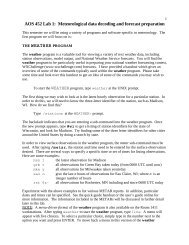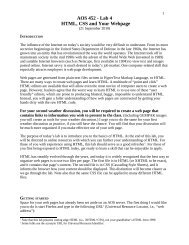Federal Meteorological Handbook No. 1 - Marrella
Federal Meteorological Handbook No. 1 - Marrella
Federal Meteorological Handbook No. 1 - Marrella
Create successful ePaper yourself
Turn your PDF publications into a flip-book with our unique Google optimized e-Paper software.
a. Accuracy of Time in Reports. A procedure shall be established to assure that the accuracy of the<br />
timing device used to establish times in the observation program are within ±1 minute of the U.S.<br />
Naval Observatory time.<br />
b. Scheduled Time of Report. The scheduled time of the METAR shall be the Coordinated Universal<br />
Time (UTC) a METAR is required to be available for transmission.<br />
c. Actual Date and Time of Observation. The actual date and time of METAR shall be the time the<br />
last element of the observation was observed. The actual time of a SPECI shall be the time the criteria<br />
for the SPECI was met or noted.<br />
d. Time Disseminated in Observations. All times disseminated in observations shall reference the 24hour<br />
UTC clock, e.g., 1:47 A.M. shall be referred to as 0147 and 1:47 P.M. as 1347. The times 0000<br />
and 2359 shall indicate the beginning and ending of the day, respectively.<br />
e. Date and Time Entered in Observations. All dates and times entered in observations shall be with<br />
reference to the 24-hour clock. The times that are disseminated as part of the observation shall be<br />
entered in UTC. However, at the discretion of the responsible agency, those times used to otherwise<br />
document the observation or other related observational data may be either Local Standard Time (LST)<br />
or UTC. The time standard selected shall be clearly indicated on all records; if LST is used, the<br />
number of hours used to convert to UTC shall also be indicated.<br />
2.6.5 Sensor Siting Standards. All installations of sensors shall be in accordance with the latest <strong>Federal</strong><br />
Standard for Siting <strong>Meteorological</strong> Sensors at Airports published by the OFCM. Presently installed sensors<br />
may be operated at their present location. However, if they must be relocated, the <strong>Federal</strong> standards shall<br />
be followed.<br />
2.6.6 Algorithms Used by Automated Stations. Automated stations shall use algorithms that conform<br />
with the latest <strong>Federal</strong> Standard Algorithms for Automated Weather Observing Systems published by the<br />
OFCM. These algorithms do not apply to previously authorized systems, which may continue to operate<br />
until replaced or modified.<br />
2.7 Recency of Observed Elements<br />
2.7.1 Recency of Observed Elements at Automated Stations. Individual elements entered in an<br />
observation shall, as closely as possible, reflect conditions existing at the actual time of observation. For<br />
those elements that the human observer evaluates using spatial averaging techniques (e.g., sky cover and<br />
visibility), the automated station substitutes time averaging of sensor data. Therefore, in an automated<br />
observation, sky condition shall be an evaluation of sensor data gathered during the 30-minute period ending<br />
at the actual time of the observation. All other elements evaluated shall be based on sensor data that is<br />
within 10 minutes or less of the actual time of the observation.<br />
2.7.2 Recency of Observed Elements at Manual Stations. Individual elements entered in an observation<br />
shall, as closely as possible, reflect conditions existing at the actual time of observation. Elements entered<br />
shall have been observed within 15 minutes of the actual time of the observation. Gusts and squalls shall<br />
be reported if observed within 10 minutes of the actual time of the observation. Observation of elements<br />
shall be made as close to the scheduled time of the observation as possible to meet filing deadlines, but in<br />
no case shall these observations be started more than 15 minutes before the scheduled time.<br />
������������������������������������ �������������<br />
���





